Janice Hardy's Blog, page 59
November 20, 2019
The Problem With "Revealing" Information That's Already in the Cover Copy
 By Janice Hardy, @Janice_Hardy
By Janice Hardy, @Janice_Hardy A novel's beginning is under a lot of pressure to hook readers and pull them into the story. But what happens when that hook is something we reveal on the back cover?
Opening scenes are hard enough to write already, but there's something writers need to be wary about, particularly if they indie publish.
An opening scene that "reveals" information stated in the cover copy as if it's a big secret.
For example, let's say your novel is about a town that's been hit by toxic nerve gas that's killed everyone under the age of twenty. Now the characters have to deal with this problem and the repercussions of it. Your cover copy might say something like...
When a tragic accident poisons a small town a kills everyone under the age of twenty, local doctor Jessica Halloway must find the cause before more fall ill and die. But as she searches for the cure, she uncovers a far more deadly source.Every single person who reads this cover copy is going to know before they open the book what the problem is.
Continue ReadingWritten by Janice Hardy. Fiction-University.com
Published on November 20, 2019 03:30
November 19, 2019
How to Write a Real Page-Turner, Part 5
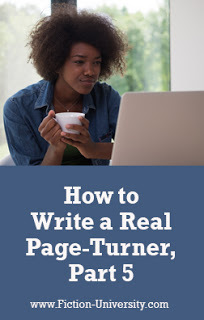 By Laurisa White Reyes, @lwreyes
By Laurisa White Reyes, @lwreyesPart of the How They Do It Series
JH: Laurisa White Reyes wraps up her How to Write a Page-Turner series today a sure-fire page-turner technique to keep readers hooked in your story.
Laurisa White Reyes is the Senior Editor of Skyrocket Press & Author Services. She has published sixteen books, including 8 Secrets to Successful Self-Publishing and the SCBWI Spark Award winner The Storytellers . Laurisa also provides personal coaching for writers. To connect with her, visit Skyrocket Press.
Website | Facebook | Twitter | Goodreads |
Take it away Laurisa...Continue ReadingWritten by Janice Hardy. Fiction-University.com
Published on November 19, 2019 03:33
November 18, 2019
How to Make an Unhappy Character "Likable"
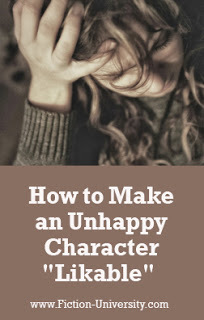 By Janice Hardy, @Janice_Hardy
By Janice Hardy, @Janice_Hardy Novels don't always have a happy hero at the core--but that doesn't make the character any less "likable."
It's ironic that there are so many terms in writing that aren't clear exactly what they mean, or have multiple definitions or uses. "Likable" is one such term.
All the advice says we want a likable protagonist readers can root for, someone they'll want to hang out with for four hundred pages, and someone readers will connect with.
But likable isn't really the issue, and the word can be problematic.
Back in 2013, I received a question from a writer struggling to make her depressed character "likable." She also suffered from depression , and feared readers living in the head of a depressed character wasn't something "emotionally healthy folks are going to want to spend time with." I answered her question best I could.
Continue ReadingWritten by Janice Hardy. Fiction-University.com
Published on November 18, 2019 03:00
November 15, 2019
When It All Goes Horribly Wrong, Turn to Odyssey Online
 By Dianna Sanchez, @diannabooks
By Dianna Sanchez, @diannabooksPart of The Writer's Life Series
JH: Writing is often hard to learn on your own, and luckily, there are classes and workshops galore to help up improve. Dianna Sanchez visits the lecture hall today to share her experiences with Odyssey Online.
Dianna Sanchez is the not-so-secret identity of Jenise Aminoff, also known to her children as the Queen of Sarcasm. She has worked as a technical writer, electrical engineer, programmer, farmer, and preschool cooking teacher, among many other things. Her middle-grade fantasy series includes A Witch’s Kitchen (2016), A Pixie’s Promise (2018), and An Elf’s Equations (forthcoming in March 2020). A Latina geek originally from New Mexico, she now lives in the Boston area with her husband and two daughters.
Website | Facebook | Twitter Goodreads |Kickstarter
Take it away Dianna...
Continue ReadingWritten by Janice Hardy. Fiction-University.com
Published on November 15, 2019 03:00
November 14, 2019
Writers, Don't Get Discouraged: Have Stepping Stones, Not Setbacks
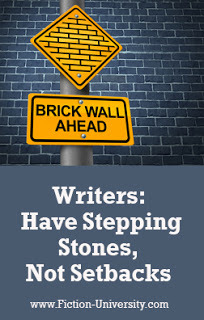 By Shanna Swendson, @ShannaSwendson
By Shanna Swendson, @ShannaSwendsonPart of The Writer’s Life Series
JH: Writing is a tough business, and once in a while, it can really bring you down. Shanna Swendson visits the lecture hall today to share tips on dealing with discouragement as a writer.
Shanna Swendson earned a journalism degree from the University of Texas but decided it was more fun to make up the people she wrote about and became a novelist. She’s written a number of fantasy novels for teens and adults, including the Enchanted, Inc. series and the Rebel Mechanics series. She devotes her spare time to reading, knitting, and music.
Website | Twitter | Facebook | Goodreads
Take it away Shanna…
Continue ReadingWritten by Janice Hardy. Fiction-University.com
Published on November 14, 2019 03:00
November 13, 2019
Keeping Your Distance: How Narrative Distance Works in Your Novel
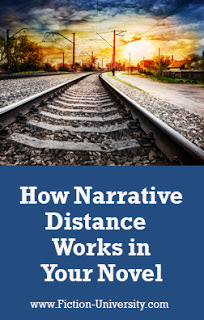 By Janice Hardy, @Janice_Hardy
By Janice Hardy, @Janice_HardyThe narrative distance in a novel has more affect on it than you might think. Especially when it comes to point of view.
Over the years, I've critiqued a lot of manuscripts, and a common area writers stumble over is narrative distance. They're not always sure what it is, how to use it, or how it affects their point of view.
Narrative distance is that feeling of closeness (or lack thereof) between the reader and the characters. It's what makes the point of view feel close or distant.
There's no "right" narrative distance. It's up to the writer to decide where they want the reader to be, but it's easy to fall into a "limbo narrative" where it isn't clear where--or even who--the narrator is. When this happens, we often slip into telling or too much filtering and readers feel disconnected from the characters and the story.
Continue ReadingWritten by Janice Hardy. Fiction-University.com
Published on November 13, 2019 03:01
November 12, 2019
3 Secrets to Writing Vivid Settings
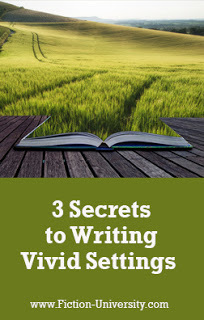 By Laurence MacNaughton, @LMacNaughton
By Laurence MacNaughton, @LMacNaughtonPart of the How They Do It Series
JH: Settings are an often overlooked aspect of a novel, yet they're opportunities to bring your story's world to life. Laurence MacNaughton returns to share three secrets for creating settings readers will get lost in.
There are three elements that make up every story: people, problems, and places. To form a good story, those elements need to be in balance, because each one affects the others. That's why you need to put as much effort into the places in your story—your setting—as you do for your characters and your plot.
Here are the three best ways to make that effort pay off, so that your setting comes alive.
Continue ReadingWritten by Janice Hardy. Fiction-University.com
Published on November 12, 2019 03:45
November 11, 2019
The Joy of Discovery: Keeping Readers Hooked Through Story Revelations
 By Janice Hardy, @Janice_Hardy
By Janice Hardy, @Janice_HardyThe need to know is what keeps readers interested in your novel. Don't let them down.
My husband and I watch a lot of movies, and we often discuss them over a meal afterward. Years ago, we were deciding if we wanted to see Men in Black 3. We both loved the original, felt the sequel was meh, and had read not-great reviews about the third (we did end up seeing it).
Then my husband said something profound (as he often does) that really related to writing and keeping readers hooked in a novel.
"The first movie had the joy of discovery in it that was missing from the second."
Which totally nails why a book, especially in a series, can fall flat.
One of the ways readers stay interested in a story is by learning new things about the world and characters. The discovery of who they are, what they can do, and how everything works, can be very compelling.
Continue ReadingWritten by Janice Hardy. Fiction-University.com
Published on November 11, 2019 03:00
November 9, 2019
Real Life Diagnostics: A Look at a Middle Grade First Page
 Critique By Maria D'Marco
Critique By Maria D'Marco Real Life Diagnostics is a weekly column that studies a snippet of a work in progress for specific issues. Readers are encouraged to send in work with questions, and we diagnose it on the site. It’s part critique, part example, and designed to help the submitter as well as anyone else having a similar problem.
If you're interested in submitting to Real Life Diagnostics, please check out these guidelines.
Submissions currently in the queue: Zero
Please Note: As of today, RLD slots are open.
This week’s question:
Is this opening working?
Market/Genre: Middle Grade Science Fiction
On to the diagnosis…
Continue ReadingWritten by Janice Hardy. Fiction-University.com
Published on November 09, 2019 04:24
November 8, 2019
SPARK UP YOUR STORY – A Workable Plan for Adding Tension, Suspense, & Intrigue
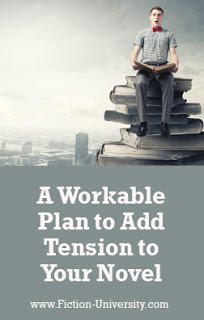 By Jodie Renner, fiction editor, @JodieRennerEd
By Jodie Renner, fiction editor, @JodieRennerEdPart of the How They Do It Series
JH: Keeping the reader glued to the pages of our novel is a goal for every writer. Jodie Renner returns to the lecture hall today, to share tips on adding tension and intrigue to the story.
We all know that thrillers and other fast-paced popular fiction need lots of tension, conflict, suspense, and intrigue to grip readers and provide a riveting, satisfying reading experience. But so does any other compelling story that will create a buzz and take off in sales. No matter what genre you write, it’s all about hooking your readers in, engaging them emotionally, and ensuring they keep eagerly turning the pages.
Tension, conflict, and complications are what drive fiction forward and keep readers engaged.
Continue ReadingWritten by Janice Hardy. Fiction-University.com
Published on November 08, 2019 03:00



